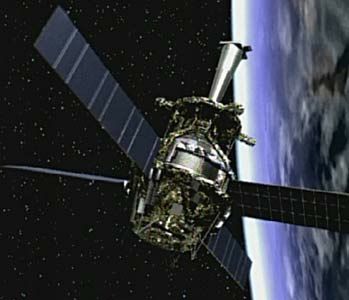
Home - Search - Browse - Alphabetic Index: 0- 1- 2- 3- 4- 5- 6- 7- 8- 9
A- B- C- D- E- F- G- H- I- J- K- L- M- N- O- P- Q- R- S- T- U- V- W- X- Y- Z
Gravity Probe-B
 Gravity Probe B Credit: Manufacturer Image |
Status: Operational 2004. First Launch: 2004-04-20. Last Launch: 2004-04-20. Number: 1 .
The experiment would check, very precisely, tiny changes in the direction of spin of four gyroscopes contained in a satellite in a 650 km polar orbit. The gyroscopes would measure how space and time were warped by the presence of the Earth, and, more profoundly, how the Earth's rotation drags space-time around with it. These effects, though small for the Earth, had far-reaching implications for the nature of matter and the structure of the Universe. The spacecraft was spin stabilized (0.1 to 1 rpm). Attitude control thrusters used helium boiled off from the experiment's Dewar. The experiment gyro used for attitude reference. The payload included a block of fused quartz 21 inches long holding four gyroscopes and a proof mass, all bonded to a quartz telescope. The package was inserted into a 1500 l helium Dewar in order to maintain it at a temperature of 1.8 Kelvin. The gyroscopes were constructed from ultra-smooth quartz balls coated with niobium which became a superconductor as liquid helium temperatures, allowing the gyroscopes to be suspended electrically. Very sensitive magnetometers detect any changes in the gyroscope's spin axis. The gyros spun at 10,000 revolutions a minute.
Financial status as of 1997 was $ 236 million spent, $ 340 million to complete.
Family: Astronomy, Earth, Earth geodetic sat. Country: USA. Launch Vehicles: Thor, Delta, Delta 7920-10C. Launch Sites: Vandenberg, Vandenberg SLC2W. Agency: NASA, Lockheed, Stanford. Bibliography: 2, 3756, 3757, 3758, 6, 6542, 12521.
2004 April 20 - . 16:57 GMT - . Launch Site: Vandenberg. Launch Complex: Vandenberg SLC2W. LV Family: Thor. Launch Vehicle: Delta 7920-10C.
- Gravity Probe B - .
Mass: 3,145 kg (6,933 lb). Nation: USA.
Agency: NASA.
Class: Astronomy.
Type: X-ray astronomy satellite. Spacecraft: Gravity Probe-B.
USAF Sat Cat: 28230 . COSPAR: 2004-014A. Apogee: 646 km (401 mi). Perigee: 640 km (390 mi). Inclination: 90.00 deg. Period: 97.60 min.
Gravity Probe B's mission was to confirm a prediction of Einstein's theory of relativity. The physics experiment, developed by Stanford University and Lockheed Martin, was to observe the magnitude 5 star IM Pegasi for over a year, attempting to measure the tiny shifts in the spacecraft gyroscopes' orientation caused by the Lense-Thirring gravitomagnetic (or `frame-dragging') effect. To accomplish this the spacecraft carried four gyroscopes kept at 1.8 deg Kelvin by a liquid helium dewar, laser retroreflectors and two GPS receivers for orbit determination, a drag compensation system, and a 14 cm aperture quartz telescope. The satellite was also to make an accurate measurement of the already-established gravitostatic warping of spacetime due to the Earth's mass.
Back to top of page
Home - Search - Browse - Alphabetic Index: 0- 1- 2- 3- 4- 5- 6- 7- 8- 9
A- B- C- D- E- F- G- H- I- J- K- L- M- N- O- P- Q- R- S- T- U- V- W- X- Y- Z
© 1997-2019 Mark Wade - Contact
© / Conditions for Use